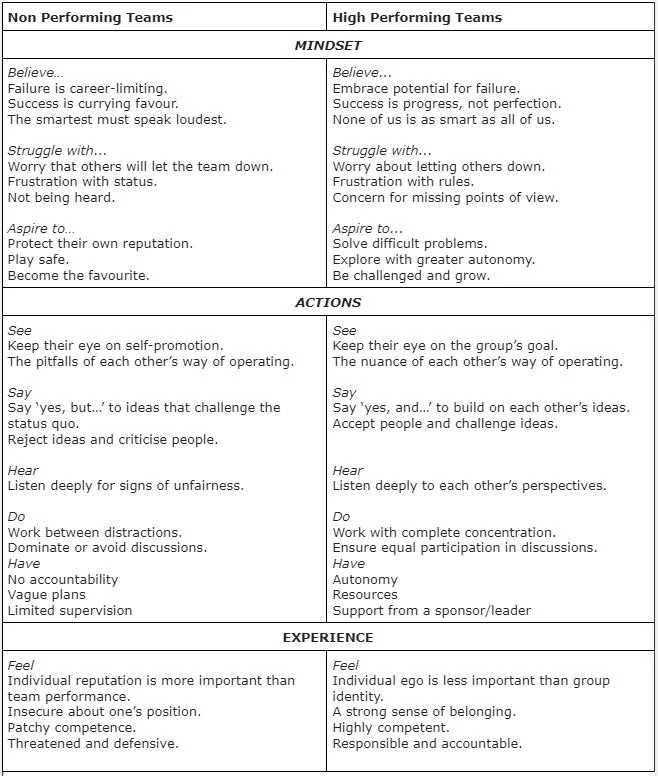High performance is meeting or exceeding team goals consistently. One of the crew asked, “what are the characteristics of high performing teams?” Everyone wants to know if their team has what it takes to be an elite performer.

There are three aspects of high performing teams:
-
Mindset
-
Actions
-
Experience.
In this article, we compare a non-performing team (so you can avoid mistakes) to a high performing team (so you can foster this in your own team).
No one likes being part of an underperforming team. It’s embarrassing. It’s deflating. And it can cost us reputational damage.
It’s far better to be part of a high performing team. It’s fun, engaging, and puts a zing in our step.
We all know when we’re part of a team that just hums.
But is it just luck? Do some people just gel and others don’t?
It turns out there are specific characteristics that feature when we look at high performing teams. And we can cultivate them.
Keith Sawyer explored these elements in his book, Group Genius. He outlined the conditions required for teams to get into group flow state, where creativity and productivity skyrockets, where interactions are stimulating and build ideas and relationships at the same time.
High performing teams have a strong leadership mindset
The first leadership principle is: get clear
No one wants to be part of the miserable experience of a non-performing team. Blame and defensiveness just leads to more misery.
To set a team on the path to high performance, the leader must first work with the team to establish what their version of high performance actually is.
Ask the team:
-
If we were truly operating at our best, what would we see? Say? Hear? Do? Have? Feel?
-
What kind of beliefs and mindset do we need to have in order to deliver all that?
-
What are we each afraid of? What do we each aspire to?
The second leadership principle is: model the way
Brené Brown talks about vulnerability: sharing one’s feelings and lack of certainty. Her research shows that when we can speak openly about our feelings and concerns, we lower the barriers between us and others for more genuine connections.
This means admitting when we don’t know something and apologising when we screw something up. It means sharing when we feel confused, or hurt, or any other ‘awkward’ emotion. We do this with the caveat, “this is a story I am telling myself” and invite others to interrogate our story and perceived reality. Together we explore our stories and reach a new understanding of what is really going on.
Amy Edmondson writes extensively on psychological safety. The definition is, “feeling safe enough to speak up and share ideas without fear of criticism or retribution”.
According to research by Google on its highest performing teams, psychological safety is the number one factor in team success. Teams with high levels of psychological safety were more creative and delivered higher quality and productive work.
As leaders, we need to ensure that the team dynamic is a safe place for people to share. We do this by setting expectations that all ideas are welcome, all team members are to contribute, to challenge the idea not the person, and to show appreciation for people’s efforts and ideas, even if they don’t end up getting actioned. The point of high performing teams is to build on each other’s ideas, not hang onto them.
The third leadership principle is: re-define success
Non-performing teams do not have a sense of collective success. They might have individual projects or tasks they need to deliver on, and work furiously to achieve these, but sometimes this is at the expense of their peers. They hoard resources, information and knowledge so that their individual performance is assured while their colleagues might be floundering.
If leaders worked with teams to re-define success to include collective results, then the system would not skew behaviour so much towards lone wolf tendencies.
The Musketeers had it right: “All for one and one for all”! We just need to back that up with systems that spell out these collective goals.
Where does your team sit – non-performing or high performing? Which characteristics could you develop more of? Which leadership principle could you embed? When will you do it?





















